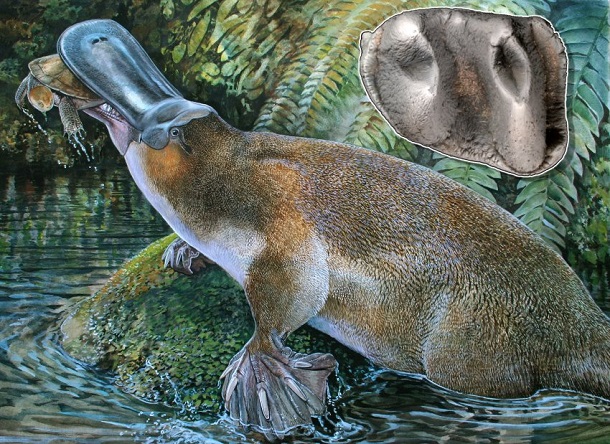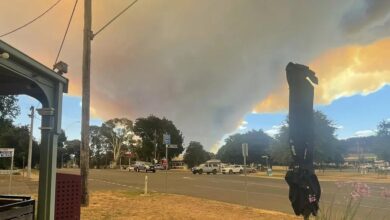Australian researchers describe a new, prehistoric platypus: Obdurodon tharalkooschild raises new questions about the pedigree of these strange animals.
For he was probably less linear than previously thought – and brought forth quite particularly thick escapee .
The platypus is a true freak of all mammals. With webbed feet and a ” duckbill ” equipped animals lay eggs , but the hatched young are weaned . However, not teats, but a ” milk box ” of occupied with glandular skin, soak the skin from which the boys suck their food.
Males defend himself with a venomous spine on the hind feet under water and they chase their prey with electric sensors. Unlike any other mammal platypus has ten sex chromosomes ( we only have two ) . A more detailed analysis discovered the jaw structure similarities with reptiles – such as the eggs of the animal are more reminiscent of reptile eggs because of bird eggs.
And always , it was previously believed , there was at any time only one type of biological curiosities. Thus, the pedigree of the platypus remembered far more like a bamboo stem : platypus seemed to have unusually developed further linear, with no ramifications and side lines .
New Creature Found:A new, extra thick side line
A new, published in the “Journal of Vertebrate Paleontology” Study of Rebecca Pian and Suzanne Hand from the University of New South Wales now revised this file. Once lived with Obdurodon tharalkooschild not only a representative of the platypus, which appears outside the strictly linear as was previously assumed lineage of the genus. Obdurodon was unusual in other ways – more than twice as large as today’s platypus.
A realization that so far , however, is based only on the analysis of a single tooth found . Today Platypuses have no teeth in adulthood , crush them with their food rather bony ridges, . Senior representatives of the family that reaches about 61 million years ago ( and the trace their ancestors to the Cretaceous period ) , had teeth.
The extrapolated from the tooth with a matching height of about one meter Greenie ” giant ” was found in the Riversleigh area of Boodjamulla National Park. Is an important archaeological site for fossils of mammals of the Oligocene and Miocene , the Unesco World Heritage Site . The age of the layer in which the fossil fragment was found , however , is controversial , and is therefore provided with a relatively wide span of five to 15 million years ago .
Any accurate reconstruction of the animal is thus based on guesswork . They are , however, good reasons, as representatives of the platypus have so far had only limited variance in their physical characteristics. Because so have retained much of their ” originality ” and the modern platypus , they are often referred to as “living fossils” .
New Crature Australia:What can tell a tooth
From now found fossil, a lot can be read out: The researchers go after analysis of wear tracks and shape of the tooth from the assumption that nourished Obdurodon tharalkooschild of crustaceans, but also small vertebrates such as lung fish, frogs and small turtles.
For the research of the Fund is relevant not only because it documents that the family of platypus but probably a little more diverse and possibly ramified than was previously thought. Now it was also assumed that the initially larger platypuses were continuously getting smaller throughout its history. Obdurodon tharalkooschild now makes clear that there may have been still quite tall relatives of today’s platypus also relatively recently.
The somewhat strange scientific name combines Obdurodon, of the two previously known species discovered in 1975 and 1992 were, with the suffix “tharalkooschild”.
This derives from an ancient Aboriginal legend: Once ignored the ducks girl Tharalkoo the warnings of his parents, hinabzuschwimmen the river. For there lurks Bigoon, the water rat who could pass on her. This is what happened of course, and when the time came in which the young ducks laid eggs for the first time, did so Tharalkoo.
But their offspring was even softer than her sisters: Little Chimera from birds and rats, occupied with dense brown fur. Thus, the first platypus were born, the legend says. What an explanation for this oddity animal does not even sound so bad.
[adrotate group=”13″]




